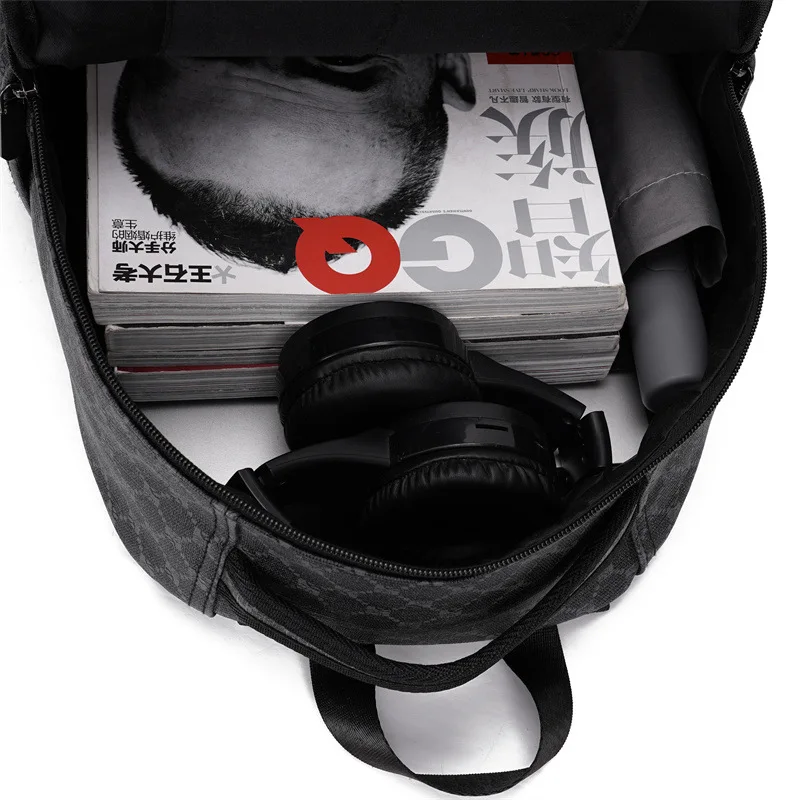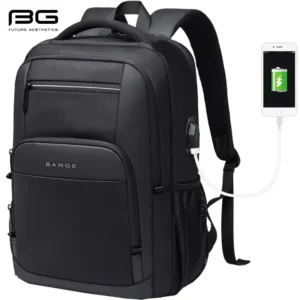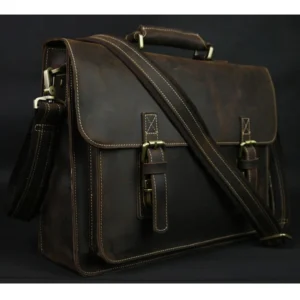Introduction: Why Functionality Defines the Modern Man’s Leather Bag
The modern man’s leather bag exists at the intersection of style and utility. While aesthetics certainly matter, it’s the functional elements that transform a simple accessory into an indispensable daily companion. A truly exceptional leather bag doesn’t just look good—it enhances your routine, streamlines your organization, and adapts to your evolving needs.
Understanding the functional features of men’s leather bags is essential when making a significant investment. Quality leather goods aren’t impulse purchases but rather calculated decisions that should serve you reliably for years or even decades. When you know what functional elements to look for, you’re better positioned to select a bag that genuinely enhances your daily experience.
The right bag doesn’t just carry your belongings; it creates a system of organization that increases efficiency and reduces stress. No more frantically searching for keys or damaging electronics due to inadequate protection. Instead, a well-designed leather bag creates designated spaces for everything you carry.
Today’s versatile leather bags for men have evolved significantly from purely utilitarian items to sophisticated accessories that balance practicality with refined aesthetics. Throughout this guide, we’ll explore:
- Key functional elements that define quality leather bags
- Different bag types and their specific strengths
- How to match bag functionality to your particular lifestyle needs
- What separates exceptional men’s leather backpacks from mediocre options
Remember, while style might initially attract you to a leather bag, it’s the thoughtful functionality that will determine its true value in your daily life.
Understanding Your Daily Carry Needs: Matching Functionality to Lifestyle
Before exploring specific bag features, take a moment to assess your daily carry requirements. The functionality you need depends entirely on your lifestyle, routines, and the items you regularly transport. Different contexts demand different functional solutions.
The Daily Commuter
For those navigating public transportation or walking significant distances daily:
– Protective padding for electronics is essential
– Quick-access pockets for transit cards and phone
– Comfortable carrying options to prevent strain
– Weather-resistant materials to protect against unexpected elements
– Durable construction to withstand daily wear
The Business Professional
If your bag primarily serves professional environments:
– Dedicated document organization to prevent folding or wrinkling
– Padded laptop compartment sized appropriately
– Professional aesthetic with clean lines
– Business card and pen holders
– Streamlined profile that complements formal attire
The Frequent Traveler
For those regularly on the move:
– Expanded capacity for overnight essentials
– Security features to deter theft
– Durability to withstand frequent handling
– Pass-through sleeve for rolling luggage attachment
– Multiple compartments to separate items during travel
The Everyday Carry Enthusiast
For daily essentials and casual use:
– Accessible organization for frequently used items
– Comfortable weight distribution
– Versatile carrying options
– Appropriate size for daily necessities without excess bulk
– Durable materials that develop character with use
Effective leather bag organization tips for men suggest taking inventory of what you carry daily. Ask yourself:
- What are my non-negotiable daily items?
- Which items need quick access and which can be stored deeper?
- Do I need protection for electronics or fragile items?
- How much does my carry load fluctuate day-to-day?
- What carrying style is most comfortable for my routine?
Men who require professional functionality often find leather work backpacks provide the perfect balance of organization and formal appearance. By honestly assessing your daily needs, you’ll be better positioned to select a bag with functionality that truly serves your lifestyle.
Essential Leather Bag Types and Their Functional Advantages
Each leather bag style offers distinct functional advantages designed for specific use cases. Understanding these differences helps you select the perfect match for your lifestyle.
Briefcases: Professional Structure and Protection
The classic briefcase excels at:
– Maintaining document organization without folding or creasing
– Projecting professional appearance in formal business environments
– Providing structured protection for laptops and tablets
– Offering easy desktop access to contents when opened
– Standing upright when placed on the floor
Briefcases work best for professionals who primarily transport documents, laptops, and business essentials in formal settings. Traditional briefcases feature rigid structure, while modern interpretations include more flexible designs with additional organization.
Messenger Bags: Accessibility and Hands-Free Convenience
Messenger bags prioritize:
– Quick access to contents while on the move
– Comfortable cross-body carrying that distributes weight effectively
– Flap closure that protects contents while allowing fast retrieval
– Flexibility to adjust capacity based on daily needs
– Casual but professional aesthetic suitable for various environments
Ideal for commuters and urban professionals, messengers excel when you need frequent access to contents throughout the day. Their cross-body design provides security in crowded spaces while keeping hands free.
Backpacks: Weight Distribution and Larger Capacity
The benefits of leather backpacks include:
– Superior weight distribution across both shoulders
– Larger capacity for daily essentials plus extras
– Ergonomic carrying for heavier loads
– Multiple compartments for organized storage
– Professional designs that have overcome casual associations
Various men’s leather backpack styles now accommodate professional environments while providing unmatched comfort for carrying heavier loads. Backpacks excel for commuters with longer walks, those carrying multiple electronic devices, or anyone needing additional capacity.
Duffel/Weekender Bags: Maximum Capacity for Travel
Duffel bags provide:
– Maximum capacity for clothing and travel essentials
– Simple, wide-opening design for easy packing and unpacking
– Versatile carrying options (handles and shoulder straps)
– Collapsible structure for easy storage when not in use
– Casual elegance suitable for weekend getaways
These bags work best for overnight trips or gym visits where capacity takes priority over complex organization.
Tote Bags: Open Access and Versatility
Leather totes offer:
– Wide opening for easy access to all contents
– Simple, spacious design for versatile use
– Professional aesthetic suitable for business settings
– Ability to carry oddly-shaped items
– Easy transition between work and personal use
Totes excel when you need a versatile bag that can adapt to changing daily requirements without excessive compartmentalization.
Sling Bags/Small Crossbody Bags: Minimalist Essential Carry
Compact leather sling backpacks feature:
– Streamlined design for essential items only
– Single-strap access that swings forward for easy retrieval
– Hands-free carrying perfect for active use
– Security of close body contact
– Minimal profile that doesn’t interfere with movement
Slings and small crossbody bags work best for minimalists or as secondary bags when you need only essential items like wallet, phone, and keys.
The right leather bag type creates the foundation for functionality. While leather briefcase backpacks provide versatility between formal and casual settings, your primary consideration should be matching the bag’s inherent design advantages to your specific carrying needs.
Critical Organizational Features: Compartments That Matter
Thoughtful internal organization transforms a simple carrying vessel into a functional tool that enhances daily efficiency. The right organizational features keep contents accessible, protected, and intuitively arranged.
Laptop and Electronic Protection
Quality leather bags approach electronic protection with:
– Padded compartments with suspension design to prevent impact damage
– Microfiber or soft fabric lining to prevent scratches
– Secure closure to prevent accidental slipping
– Appropriate sizing (measure your devices before purchasing)
– Accessibility that balances protection with easy retrieval
When evaluating a bag’s electronic protection, check that the laptop compartment is slightly larger than your device but not excessively roomy, which allows unwanted movement.
Document Organization
For papers and documents, look for:
– Full-width sleeves that prevent folding or creasing
– Dividers that separate different document categories
– Secure closures that prevent papers from spilling
– Reinforced edges to maintain shape and prevent damage
– Water-resistant lining for additional protection
Benefits of compartmentalized leather bags include the ability to maintain document organization even when the bag is jostled or carried in different positions.
Small Item Management
Effective small item organization includes:
– Dedicated pockets sized appropriately for common items (phones, wallets)
– Pen loops positioned for easy access
– Card slots in accessible locations
– Key clips or leashes to prevent loss
– Zippered security pockets for valuables
The best men’s leather laptop backpacks balance compartmentalization without excessive complexity. Too many tiny pockets can actually hinder organization by creating confusion about where specific items belong.
Quick-Access Features
Strategic quick-access features provide:
– Exterior pockets positioned for retrieval without opening main compartment
– Magnetic closures or single-handed zippers for convenient access
– Logical placement matching natural reaching patterns
– Security balanced with accessibility
– Weather protection to shield contents
Finding the Right Balance
The ideal organizational system strikes a balance between:
– Enough compartments to create logical separation
– Not so many that items become lost in a maze of pockets
– Intuitive design that doesn’t require a learning curve
– Flexibility to accommodate changing daily needs
– Visual simplicity that allows quick identification of contents
Premium leather bags differ from mass-market options in their thoughtful approach to organization—compartments are positioned based on actual use patterns rather than simply adding pockets to create the appearance of organization.
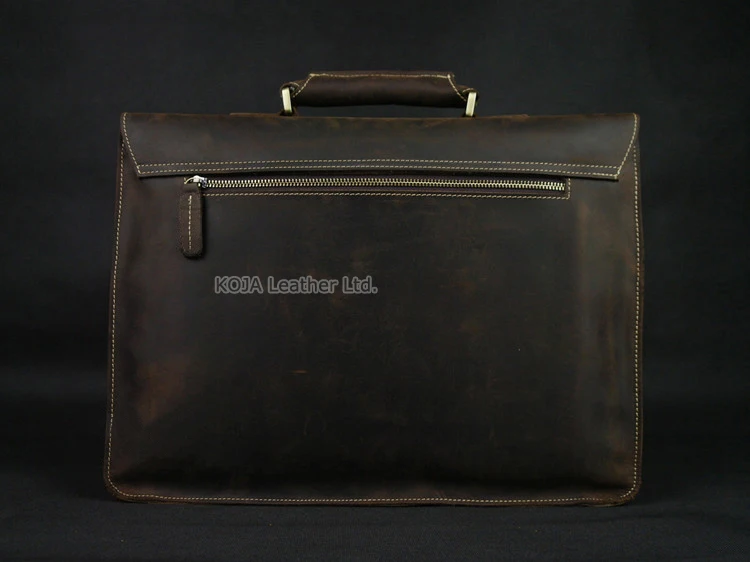
Carrying Comfort: Straps, Handles, and Ergonomic Design
The carrying system of a leather bag directly impacts its practical usability. Even the most beautifully organized bag becomes burdensome if its carrying elements cause discomfort or inconvenience.
Shoulder Straps: The Foundation of Comfort
Quality shoulder straps feature:
– Sufficient width to distribute weight (minimum 1.5 inches for heavier loads)
– Adequate padding that compresses under weight without flattening completely
– Thoughtful attachment points that prevent twisting or slipping
– Adjustability to accommodate different body types and wearing positions
– Reinforced stitching at stress points to prevent failure
Handles: Beyond Basic Grip
Superior handle design includes:
– Comfortable grip diameter that works with natural hand position
– Adequate clearance for easy grabbing, even with gloves
– Reinforced attachment to the bag body to support full weight
– Rolled or padded construction to prevent edge discomfort
– Balanced positioning for level carrying when loaded
Backpack Straps: Ergonomics Matter
Ergonomic backpack straps provide:
– S-curved design that follows natural shoulder contours
– Sufficient padding that maintains shape under load
– Adjustable sternum straps for stability with heavier contents
– Balanced attachment points that distribute weight properly
– Breathable materials at contact points to reduce heat buildup
Convertible Carrying Options
Multi-use leather bags for men offer versatile carrying through:
– Removable or stowable straps for different carrying modes
– Consistent comfort across different carrying styles
– Thoughtful design that maintains bag balance regardless of carry method
– Smooth transitions between carrying modes
– Equal functionality in each configuration
The relationship between weight distribution and carrying comfort can’t be overstated. A properly designed crossbody leather sling backpack positions weight close to the body’s center of gravity, reducing strain during extended wear. Consider both your typical load weight and carrying duration when evaluating carrying features.
For regular commuting or travel, prioritize padded straps and ergonomic design. For lighter loads and shorter durations, simplified carrying systems may suffice. Remember that carrying comfort often becomes the deciding factor in whether you actually use a bag regularly or leave it in the closet.
Materials and Construction: The Foundation of Functional Durability
The materials and construction methods used in a leather bag directly determine its functional performance over time. While aesthetics matter, it’s the quality of components and craftsmanship that enables a bag to serve its purpose for years or decades.
Leather Quality and Functional Impact
Different leather types offer varying functional properties:
Full-Grain Leather
– Retains the outermost layer of hide with natural strength and fiber density
– Develops a rich patina that improves with age rather than deteriorating
– Provides natural water resistance that increases with proper conditioning
– Offers superior tear and puncture resistance
– Maintains structural integrity for decades with proper care
Top-Grain Leather
– Provides a more uniform appearance through sanding of the outer layer
– Offers good durability while being lighter than full-grain
– Accepts treatments and finishes more readily
– Balances durability with reduced weight and cost
– Maintains good functional performance with less maintenance
Other Leather Types (Genuine, Bonded)
– Significantly reduced durability and functional performance
– Tendency to crack or peel rather than develop patina
– Limited water resistance and structural integrity
– Reduced breathability affecting contents
– Generally unsuitable for quality functional bags
Choosing leather quality bags involves understanding that leather type directly impacts water resistance, weight, flexibility, and long-term durability—all key functional attributes.
Critical Construction Elements
Superior functional durability comes from:
Stitching Methods
– Saddle stitching (two needles, one thread) for maximum durability at stress points
– Reinforced stitching at corners and load-bearing areas
– Appropriate stitch density (not too sparse or overcrowded)
– Use of quality thread resistant to UV damage and wear
Hardware Quality
– Solid metal (brass, stainless steel) rather than plated components
– Smooth zipper operation with properly aligned teeth
– Self-healing zippers that realign when caught
– Clasps and buckles designed for one-handed operation
Stress Point Reinforcement
– Corner reinforcement to prevent structural failure
– Bar tacking or rivet reinforcement at strap attachment points
– Bottom panel reinforcement to prevent sagging
– Edge reinforcement to maintain shape
Interior Construction
– Water-resistant lining to protect contents from spills and weather
– Secured lining that won’t separate from exterior leather
– Reinforced pocket edges to prevent tearing
– Structured elements that maintain shape when loaded
Summit Carry’s full-grain leather backpacks showcase how quality material selection creates the foundation for exceptional functionality. The investment in superior materials pays dividends through extended usability, reduced replacement frequency, and consistent performance regardless of conditions.
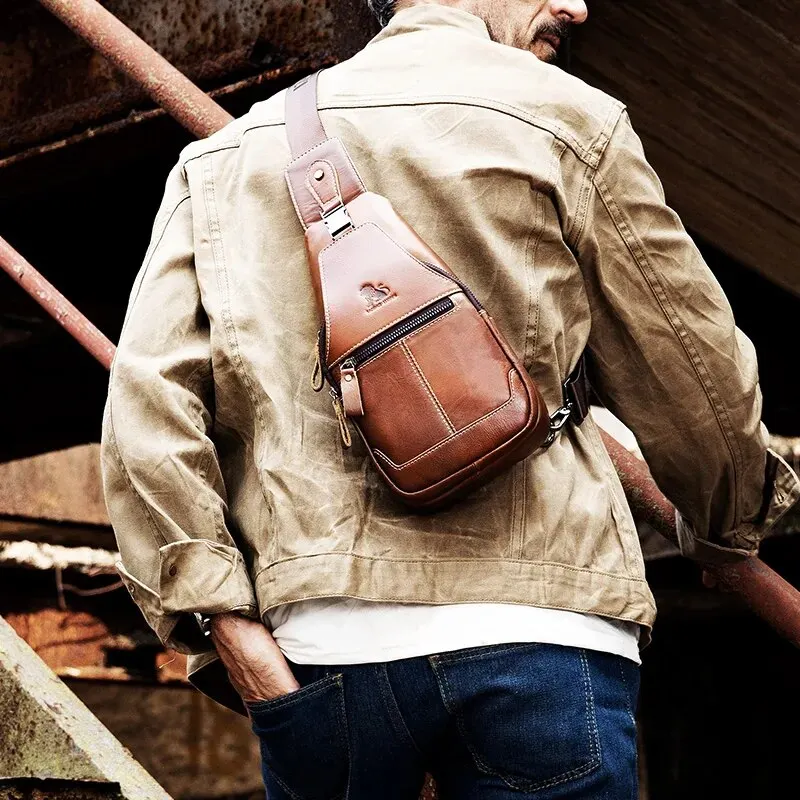
Protection Features: Safeguarding Your Valuables
Beyond basic carrying functionality, a well-designed leather bag incorporates specific features to protect its contents from damage, weather, and unauthorized access.
Electronic and Valuable Protection
Quality protection features include:
– Padded compartments with shock-absorbing foam or neoprene
– Suspended design that prevents device contact with the bottom of the bag
– Microfiber lining to prevent scratching of screens and finished surfaces
– Water-resistant barriers between exterior and electronics compartments
– Structured sides that prevent compression damage
Weather and Environmental Protection
Effective weather resistance comes from:
– Naturally water-resistant leather (particularly full-grain)
– Protective treatments that enhance water repellency
– Overlapping flaps that prevent water penetration at openings
– Sealed or protected zippers to prevent seepage
– Raised bottom design or feet to prevent ground contact when set down
Security Features for Daily Use and Travel
Security elements balance protection with convenience:
– Hidden pockets for valuable items positioned against your body
– RFID blocking in select compartments to protect electronic information
– Secure closures that can’t be easily manipulated by others
– Slash-resistant materials or reinforcement in vulnerable areas
– Lockable zippers for travel scenarios
Durable leather backpacks incorporate protection features without sacrificing accessibility. The best designs seamlessly integrate these elements without creating obvious security features that attract attention.
When evaluating protection features, consider your specific usage environment. Urban commuters may prioritize anti-theft features, while frequent travelers might emphasize weather protection and secure closures. Photographers or tech professionals should focus on impact protection and internal padding.
Remember that protective features add weight and bulk—the ideal bag incorporates necessary protection without excessive reinforcement that compromises overall functionality.
Selecting the Right Functional Leather Bag: A Decision Framework
Finding the perfect leather bag requires systematic evaluation of your needs against available options. This framework helps match functional features to your specific requirements.
Step 1: Define Your Primary Use Case
Begin by identifying your bag’s main purpose:
– Daily work commute with electronics and documents
– Business travel with overnight essentials
– Minimalist everyday carry for essentials only
– Weekend travel with clothing and personal items
– Specialized needs (photography, tools, specific equipment)
Your primary use case determines approximately 80% of your functional requirements.
Step 2: Inventory Your Essential Contents
Create a list of non-negotiable items you carry daily:
– Electronics (laptop, tablet, phone) with dimensions
– Documents and folders with size requirements
– Personal items (wallet, keys, sunglasses)
– Specialized equipment related to your profession
– Occasional but important items (umbrella, water bottle)
Understanding packing essentials for leather day bags helps determine minimum capacity and organizational needs.
Step 3: Assess Capacity Requirements
Calculate necessary capacity based on:
– Combined volume of essential items plus 20% for flexibility
– Seasonal variations in what you carry
– Growth potential for future needs
– Compression capabilities for varying loads
– Weight when fully loaded relative to carrying comfort
Step 4: Evaluate Comfort and Ergonomics
Consider your physical comfort needs:
– Typical carrying duration (short trips vs. all-day use)
– Personal carrying preferences (shoulder, cross-body, backpack)
– Physical considerations (back issues, shoulder sensitivity)
– Weather conditions in your region (affects weight and comfort)
– Distance typically covered while carrying
Step 5: Balance Quality and Investment
Quality considerations should include:
– Expected lifespan relative to purchase price
– Warranty and repair options
– Material quality appropriate for usage intensity
– Construction quality at stress points
– Hardware durability for frequently used elements
Remember that functional leather bags represent a long-term investment. The appropriate price point depends on frequency of use, importance of reliability, and how long you expect the bag to serve you.
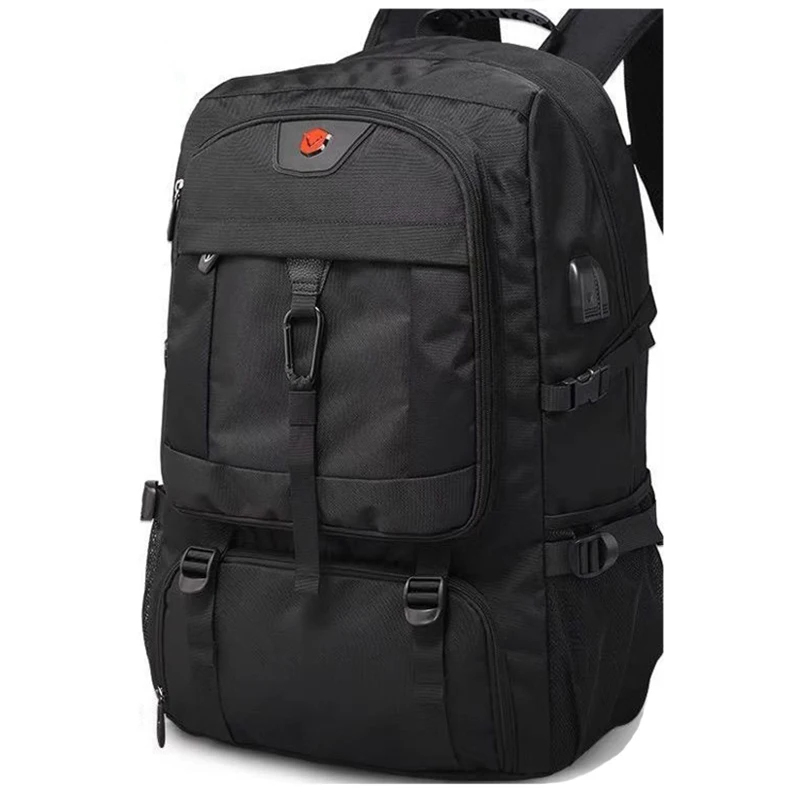
14 Inch Leather Laptop Backpack, Brown Leather Backpack, Men's Leather Backpack, Vintage Leather Backpack
Price range: $177.28 through $199.12 Select options This product has multiple variants. The options may be chosen on the product pageCarry On Leather Backpack, Roll Top Leather Backpack
Price range: $77.76 through $96.48 Select options This product has multiple variants. The options may be chosen on the product pageDesigner Men's Backpack, Men's Leather Laptop Backpack, Men's Leather Work Backpack
Price range: $158.04 through $160.04 Select options This product has multiple variants. The options may be chosen on the product pageBrown Leather Sling Backpack, Crossbody Leather Sling Backpack, Men's Leather Sling Backpack
Price range: $191.96 through $193.72 Select options This product has multiple variants. The options may be chosen on the product pageDesigner Mini Backpack, Mini Leather Backpack, Small Leather Sling Backpack, Women's Leather Backpack
Price range: $95.76 through $98.80 Select options This product has multiple variants. The options may be chosen on the product page15 Inch Leather Laptop Backpack, Leather Briefcase Backpack
$332.96 Select options This product has multiple variants. The options may be chosen on the product page
Preserving Functionality: Maintenance and Care Essentials
Even the most functionally superior leather bag requires proper maintenance to preserve its performance over time. Regular care prevents premature wear and ensures all functional elements continue working as designed.
Essential Leather Maintenance
Preserve leather functionality through:
– Regular cleaning with appropriate leather cleaners
– Conditioning 2-4 times yearly depending on use and climate
– Promptly addressing spills or stains before they penetrate
– Allowing natural drying away from direct heat when wet
– Storing with proper support to maintain shape when not in use
Oiling your leather bag maintains suppleness and water resistance, preventing cracking that compromises structural integrity.
Hardware Maintenance
Keep functional hardware working smoothly by:
– Periodically cleaning zipper tracks with a soft brush
– Applying zipper lubricant to maintain smooth operation
– Tightening loose hardware before it causes damage
– Inspecting strap attachments for early signs of wear
– Addressing squeaky or sticky buckles before they fail
Preventative Care
Extend functional lifespan through preventative practices:
– Avoid overloading beyond designed capacity
– Rotate between multiple bags to reduce continuous strain
– Use dust bags or protective covers during storage
– Maintain interior cleanliness to prevent liner damage
– Address minor repairs promptly before they escalate
Leather travel backpacks encounter particularly diverse environmental challenges and benefit from more frequent condition assessments and maintenance.
Professional leather cleaning and restoration services can revitalize bags with significant wear, often extending functional life by years. However, consistent personal maintenance remains the most effective preservation strategy.
Can Different Leather Types Affect a Bag’s Practical Functionality?
Leather type directly impacts functional performance beyond mere aesthetics or price point. Understanding these differences helps you select a bag with appropriate materials for your specific needs.
Full-grain leather offers superior functional benefits:
– Natural water resistance due to intact fiber structure
– Exceptional tear strength preventing functional failure
– Ability to mold to contents over time without stretching out
– Development of protective patina that enhances weather resistance
– Self-healing of minor scratches through conditioning
Top-grain leather provides functional advantages through:
– Lighter weight reducing carrying burden
– Increased flexibility right from purchase
– More consistent thickness for predictable performance
– Greater resistance to staining due to applied finishes
– Often lower cost while maintaining acceptable durability
Lower-quality leathers (genuine, bonded) present functional limitations:
– Tendency to crack rather than flex with repeated use
– Poor moisture resistance affecting contents
– Delamination of layers causing structural failure
– Inability to properly accept conditioning products
– Significantly shorter functional lifespan
The materials used in vintage-style leather backpacks demonstrate how leather selection balances appearance with functional requirements. For bags subjected to frequent use or challenging conditions, full-grain leather’s superior durability justifies its higher cost through extended functional life and better protection.
Climate considerations should also influence leather selection. Humid environments benefit from full-grain’s natural breathing properties, while drier climates may require more frequent conditioning regardless of leather type.
How Does Weight Distribution Impact Bag Functionality and Comfort?
Proper weight distribution fundamentally affects both carrying comfort and long-term bag functionality. Understanding these principles helps maximize comfort while preserving your bag’s structural integrity.
Physics of Bag Weight Distribution
Weight distribution impacts:
– Strain on your body (shoulders, back, hands)
– Structural stress on the bag itself
– Stability when carried or set down
– Access to contents while in use
– Overall carrying experience and fatigue levels
Design Elements That Enhance Distribution
Superior weight distribution comes from:
– Wider straps that spread pressure across larger areas
– Strategic positioning of heavier items closer to your body
– Balanced pocket placement avoiding weight concentration
– Structured back panels that maintain proper positioning
– Compression systems that secure contents against movement
Optimizing Through Packing and Organization
Improve weight distribution through:
– Placing heaviest items at the bottom and closest to your back
– Distributing weight evenly rather than concentrating in one area
– Using all available compartments rather than overloading main section
– Securing items to prevent shifting during movement
– Minimizing unnecessary weight through regular inventory assessment
Multi-use leather backpacks often incorporate design elements specifically addressing weight distribution across different carrying methods. Similarly, men’s leather travel backpacks feature enhanced structural support to manage heavier travel loads without compromising comfort.
Poor weight distribution accelerates wear on both the bag and your body. Overloading bottom corners, allowing heavy items to shift freely, or consistently carrying unbalanced loads can cause premature structural failure at stress points.
By understanding these principles, you can select bags designed with proper weight management and use them in ways that maximize both comfort and longevity.
